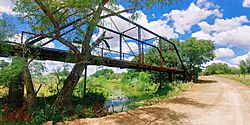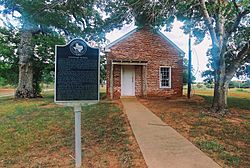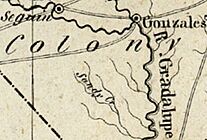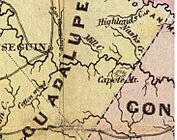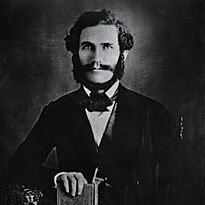Leesville, Texas facts for kids
Quick facts for kids
Leesville, Texas
|
|
|---|---|
|
Sandies Creek Iron Rail-Bridge ca. 1899 above; Leesville historical-marker below
|
|
| Nickname(s):
Sandies, Capote, Leesburg, E.W. Cullen
"Little Red Schoolhouse Station" |
|
| Granted | 1806 (de la Baume) |
| Settled | ca. 1830s-1861 |
| Founded | 1874 |
| Recognized | ca. 1891 (state law) |
| Founded by | Newburn H. Guinn |
| Named for | Lee Guinn, daughter of founder |
| Precinct | Electoral Precinct 13 |
| Government | |
| • Type | Court of law |
| Area | |
| • Total | 32,793 acre (13,271 ha) |
| • Water | .12 sq mi (0.3 km2) |
| Elevation | 520 ft (160 m) |
| Highest elevation
(Capote's Knob)
|
670 ft (200 m) |
| Population
(2018-2019)
|
|
| • Total | 384 |
| • Density | 7.53/sq mi (2.91/km2) |
| • Density | 238.8/sq mi (92.2/km2) |
| Time zone | UTC−06:00 (CST) |
| • Summer (DST) | UTC−05:00 (CDT) |
| ZIP code |
78122-9998
|
| Location | Southeast Guadalupe County line; West Gonzales County; South of Belmont, north of Nixon, and west of Bebe |
| Website | U.S. Post Office, Leesville |
Leesville is a small, unincorporated city in Texas, located in the Gonzales and Guadalupe County area. As of 2018, about 384 people live there.
The town was founded in 1874. It was first named Leesburg after Lee Guinn, the daughter of its founder, Newburn H. Guinn. Later, the U.S. Postal Service changed the name to Leesville. This was because another town in Texas was already called Leesburg. In 1891, Leesville was officially recognized by Texas state law.
Leesville has a long and interesting history. It is also known for a large water facility and a 40-mile pipeline. This system stores and moves over 11 million gallons of water to the greater San Antonio area.
Contents
Leesville's History
How Leesville Got Its Name
The first people settled in the Leesville area in the 1830s. They lived near Sandy Creek, which was once marked by a huge granite stone. This early settlement gave Leesville one of its nicknames: the Sandies. However, growth near Sandy Creek stopped in the 1870s. This happened when the landowner destroyed the granite landmark after a local food theft.
The area was then called Capote, which is Spanish for "cape" or "cloak." This name came from the nearby Capote Hills. In the late 1800s, a land developer named Newburn H. Guinn tried to rename the town Leesburg. He named it after his daughter, Lee. But the local post office changed it to Leesville because another Texas town already had the name Leesburg.
In the 1800s, a large part of southern Leesville was owned by Ezekiel Wimberly Cullen. He was a former Congressman and Supreme Court Justice for the Republic of Texas. Because he owned so much land, Leesville also got the nickname "Ezekiel W. Cullen League" or "E.W. Cullen."
The United States government recognized Leesville, Texas, in 1885. The town was officially recognized by Texas state law as Leesville, Texas, in 1891.
Leesville in the 1800s
In 1835, at Sandies Creek, a conflict occurred where 13 traders were killed. These traders were of Mexican and French origin and were traveling from Louisiana to Mexico.
One early record of Leesville mentions a shared crowbar. The community reportedly used this crowbar from 1863 until 1883. It was thought to have been used in a local theft.
Even though there are not many records of Leesville's early population, thousands of votes were cast from Leesville in the 1880s during an election for the Texas House of Representatives.
El Capote Ranch History
El Capote Ranch is a historic place in Leesville. It was founded in 1806 by Joseph de la Baume. He was a French army officer who fought in the American Revolution. He received 27,000 acres of Texas land for his service. He then started the original El Capote Ranch on this land. The ranch's cabin from the 1830s is now preserved in a museum in Lubbock. It shows what early homes on the Texas frontier looked like.
Michael Erskine bought the ranch in 1840 and raised cattle there. Many important visitors came to the ranch, including William Bollaert from the British Royal Geographical Society and Frederick Law Olmsted, who later designed New York City's Central Park.
After the Erskine family sold the ranch in the 1870s, part of the land went to Edith Kermit Carow. She was the second wife of Theodore Roosevelt, who later became a U.S. President. During the Spanish-American War, Roosevelt rode a horse from the ranch named Seguin. This horse was with him at the Battle of San Juan Hill in 1898. Other horses from El Capote Ranch were also used by Roosevelt's "Rough Riders."
In 1880, a newspaper called the San Antonio Express said El Capote Ranch was "the largest and most complete farm in Texas." It had many different animals and crops. The farm had 75 workers and covered 20,000 acres. It had 2,800 cattle and 6,000 pigs, along with other livestock and crops.
Judge Leroy Gilbert Denman bought the ranch in 1897. He was a justice of the Texas Supreme Court. His family still owns the ranch today.
The Littlefield-Martin Feud
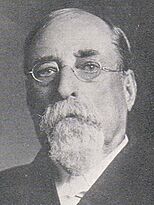
In 1880, two families from Leesville, the Littlefields and the Martins, gained national attention. This was after three members of the Littlefield family died in a gunfight between the two families. George W. Littlefield, a grandson of one of the deceased, later moved to Austin, Texas.
His Littlefield Building in downtown Austin now houses a bank. He also owned the Driskill Hotel from 1895 to 1903. He put in the first electric lights at the hotel, and it became a popular meeting place for Texas politicians. He gave his home, the Littlefield House, to the University of Texas.
Peebles' Election Story
In 1889, over a thousand people from the Leesville area elected James William Peebles as their representative. What's interesting is that Peebles did not actively campaign for the job. He had lived in Leesville since 1869 but had never shown interest in politics. Even without campaigning, Peebles won by a thousand votes. In 1891, he was elected for a second term in the same district.
Leesville in the 1900s
A voting record from 1904 shows that at least 708 votes were cast in Leesville during a primary election. Five years later, in 1909, several cases of smallpox were reported around Leesville.
Farmers' Union
As late as 1906, many Leesville farmers were part of the Leesville Farmers' Union. This union was an important topic during Thomas Mitchell Campbell's election campaign for Texas governor in 1906.
Railroads and Transportation
In March 1912, a railroad called the Quanah, Acme and Pacific Railway was built about 2.5 miles east of Leesville. Around the same time, engineers planned another railroad that would go right through Leesville.
In 1916, a contract was given for an electric railway line. This 190-mile line was planned to connect San Antonio and Houston. It would stop at several towns, including Leesville. This project would have needed a lot of wood, but it was never built.
Leesville in the 2000s
In late 2020, a large porcelain sign was stolen from Leesville's Quien Sabe Ranch. The sign weighed about 150 pounds and marked the northern part of Leesville. A $1000 reward was offered for information about the theft.
Leesville's Economy
In 2000, Leesville had seven businesses that earned about $1.3 million in 2016. From 1999 to 2018, the total income for all households in the city ranged from $7.8 million to $10.6 million each year. All properties in Leesville paid about $192,500 in property taxes in 2016.
Leesville is often used by drivers as a shortcut around Texas State Highway 123. In 2019, over 12,000 vehicles passed through the Leesville area daily on state highways.
Today, the main industries in Leesville are land owned by Texas Wildlife Management and the Quien Sabe Ranch. This ranch raises special Santa Gertrudis cattle.
Water Facility and Pipeline
A very important part of Leesville's economy is its large water facility and pipeline. This system is owned by the Schertz-Seguin Local Government Corporation (SSLGC). The 40-mile pipeline moves water from the local Carrizo Aquifer to the greater San Antonio area.
The water facility and pipeline were built in 2012 and cost about $149 million. In 2014, the facility was allowed to pump over 19,000 acre-feet of water each year. This amount of water can supply over 60,000 homes. Leesville was chosen for the water facility because it's a good location between Gonzales and Guadalupe Counties. This helps keep costs down and provides a reliable water source for nearby cities. As of 2016, the system can store up to 11.6 million gallons of water.
The water company has made over $9.2 million in revenue each year from 2016 to 2020. Besides San Antonio, the water facility also serves other cities like Selma and Universal City.
Leesville's Geography
Leesville is located in the southeastern part of Guadalupe County and the western part of Gonzales County. It is about 19 miles south of Luling and 26 miles west of Gonzales. The old city center of Leesville is along Farm to Market Road 1682. This is where the city's original church and cemetery are located, and they are still used for local events.
Historical Descriptions of the Landscape
In 1830, a surveyor named Byrd Lockhart described the lands around Leesville. He said they had rolling prairies and sandy hills covered with oak trees.
In 1846, a geologist named Dr. Ferdinand von Roemer described the area as having "fertile valleys" and "low hills of gravel sand." He also noted that there were "farms every few miles."
In 1851, William Bollaert got lost in the Leesville area. He called it the "Big Hill prairies." He found the soil to be "rich looking" and "black." He also saw herds of wild horses and wolves. Near the Guadalupe River, he found land that was good for farming, even though the topsoil was sandy. He also saw many chiltepin peppers. The main Capote Hill was described as a "conspicuous object" standing alone in the prairie. Inside the hill, he found broken-down limestone, gypsum, and shells from ancient sea life.
In 1852, Frederick Law Olmsted, who later designed New York City's Central Park, visited the area. He noted that the main trees were pecan, hickory, cypress, cottonwood, box elder, white oak, and walnut. He said the rich, black clay soil in the lowlands was hard to farm but produced a lot of crops.
Leesville's Climate
The Leesville-Belmont area gets about 33.1 inches of rain each year, over about 35.8 days. On average, there are 12.6 hours of daylight each day. Temperatures are generally high, and winters are very mild. The climate is usually described as humid subtropical.
Flooding in Leesville
In 1981, during Tropical Depression Eight, some homes in and around Leesville were damaged by water. O'Neill Creek reached its highest level since at least 1936. Leesville experienced some of the county's estimated $5 million in damages from the storm.
Nearby Former Towns
Some towns that no longer exist once stood near Leesville:
- Albuquerque, Texas
- Dewville, Texas
- Sandies Chapel, Texas
Leesville's Roads and Highways
The following main roads pass through Leesville:
 SH 80
SH 80 SH 97
SH 97 FM 466
FM 466 FM 1117
FM 1117 FM 1682
FM 1682
Population and Homes
| Historical population | ||
|---|---|---|
| Year | Pop. | ±% |
| 1860* | 70 | — |
| 1880* | 1,000 | +1328.6% |
| 1900* | 708 | −29.2% |
| 2000 | 201 | −71.6% |
| 2010 | 418 | +108.0% |
| 2018 | 384 | −8.1% |
| Census/Voting Records Military Records *≥ Estimated |
||
As of 2018, Leesville had 249 homes. Most of these homes (40.5%) were built between 1980 and 1999. The average year people moved into their Leesville homes was 1996. No new homes have been built in Leesville since 2014.
The average cost of housing in Leesville in 2018 was between $546 and $633 per month. Homes in the city paid a total of about $23,500 in property taxes each year. For local workers aged 16 and over who do not work from home:
- 16% travel less than five minutes to work.
- 28% travel 15 to 24 minutes.
- 56% travel half an hour or more.
From 2000 to 2018, the total value of all homes in Leesville was between $13.9 million and $19.6 million. This means the value of residential land was more than $400 per acre. In 2020, empty and undeveloped land in Leesville sold for about $4,649 per acre.
Education in Leesville
Public schools in Leesville are part of three different school districts:
- Gonzales Independent School District
- Nixon-Smiley Consolidated Independent School District
- Seguin Independent School District
Since 1998, a group called the Happy Quilters has made quilts for auction at the annual Leesville Country Fair. They raise money to support local education and help maintain Leesville landmarks, like the Leesville school house. They often raise $1,000 or more for each quilt.
Leesville's Culture
Michael Erskine, an early settler of the Leesville area, described the values of its people in 1845. He said, "I move along here as well as I can—work hard, live poor and am respected by the poor chaps. There are but few rich people in this part of the country. And no claims to be superior to another on account of his wealth." This shows that people in Leesville valued hard work and treated everyone with respect, no matter how much money they had.
Local Folklore
According to local stories, some people claim to see the ghost of a little girl in a blue dress playing in the Leesville Cemetery. She is reportedly seen only from a distance.
Notable People from Leesville
- Frank E. Corley (1895-1924)—An African-American police officer from Los Angeles who was born in Leesville. He was killed while on duty.
- John Beecher (1904-1980)—A descendant of Harriet Beecher Stowe. He wrote about working conditions and labor unions in Leesville.
Images for kids
-
George W. Littlefield, notable former resident of Leesville


